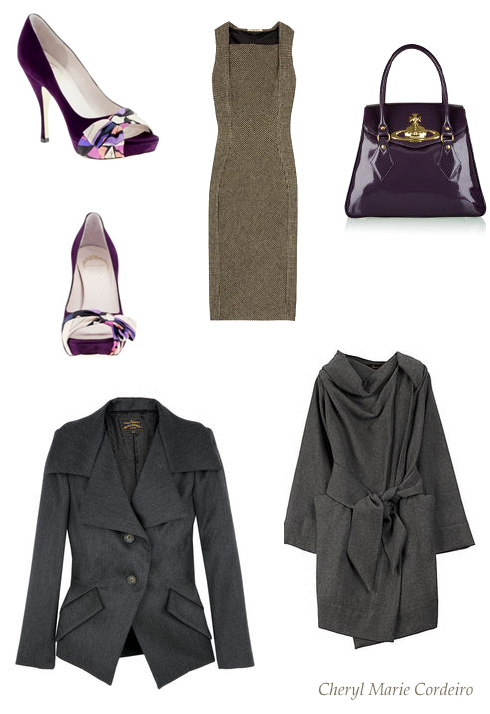Some women build their daily outfits beginning with their shoes. Beginning with this pair of Emilio Pucci wrapped purple suede heels, this is an outfit ensemble I could see myself wearing to the office in autumn. A wool blend Bottega Veneta shift dress paired with a charcoal grey jacket with double lapels by Vivienne Westwood. Over this ensemble, a square wrap coat by Vivienne Westwood Anglomania with a large purple patent tote (35cm x 40cm x 13 cm), also by Vivienne Westwood.
I’ve been following with interest, the following articles from the more lighthearted Daily Mail in the UK:
Apparently the Trade Union Council (TUC) in the UK would like to call for a ban of the use of high heels for women in the office (printed on the 6th of August, 2009), citing sexism and health problems for women who wear high heels to work everyday. This article was followed the next day with a counter article written by Maureen Rice (7th August, 2009) who said that the best careers advice ever given to her was one from her female boss:
‘Whenever you know you are going to have a challenging meeting,’ she said, ‘and especially if that meeting is mainly with men, wear high heels.’
Rice’s article gets more interesting from there on, citing heels as a symbol of feminine power in the office and how heels can give women more confidence in the office when facing their male colleagues. Heels as symbols of small daggers clinging to the heels of women who wear them, are not so much “I want to turn you on” as “I want to take you on”.
In the numerous brands of feminism, the one that caught my imagination most were essays from the genre l’écriture féminine or ‘feminine writing’, writings predominantly by Hélène Cixous and Luce Irigary from the late ’70s. The writings of Cixous in particular, would trouble women who resist the sense of being tied to the biological, but for others, it could offer a strong sense of relief that gushes from the inner core as her works encourage the celebration of differences between the biological male and female. Why fight biology and climb an uphill battle for equality that sounds defeating to begin with when we can revel in it, and with it, celebrate too the subsequent differences in manifestations of the sexes whether in speech, writing or in this case, dressing.
The article by Rice voices this very aspect of being female and of possessing your femininity on your own terms, especially in the highly competitive world of business. And where once restraining clothing items such as corsets and stilettos were seen as a tools of constriction, a mark of biology, is now viewed as an expression of will and control of self when worn, for today, the difference lies in choice. Now women decide for themselves what to wear.
